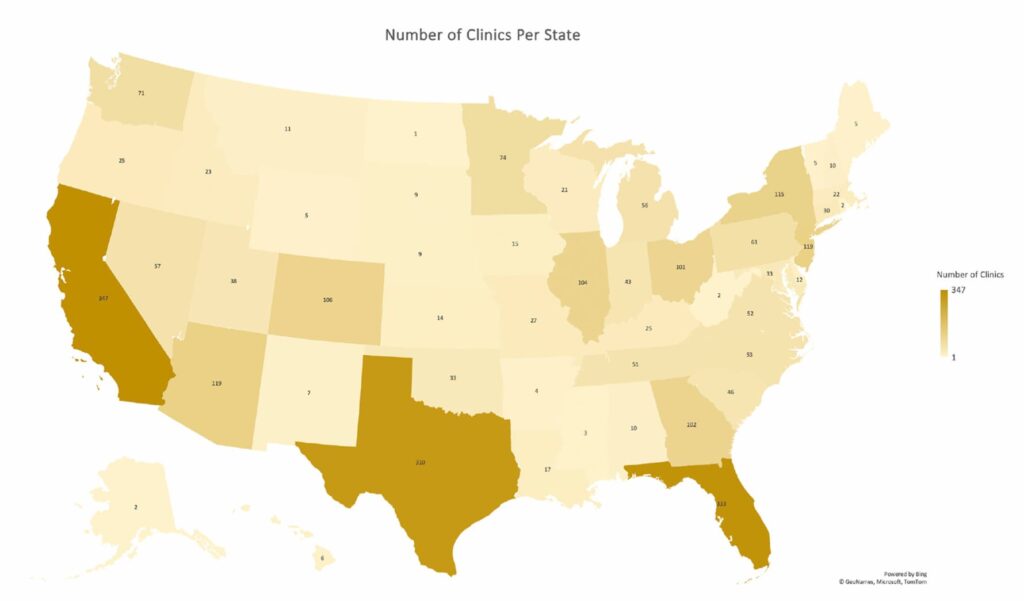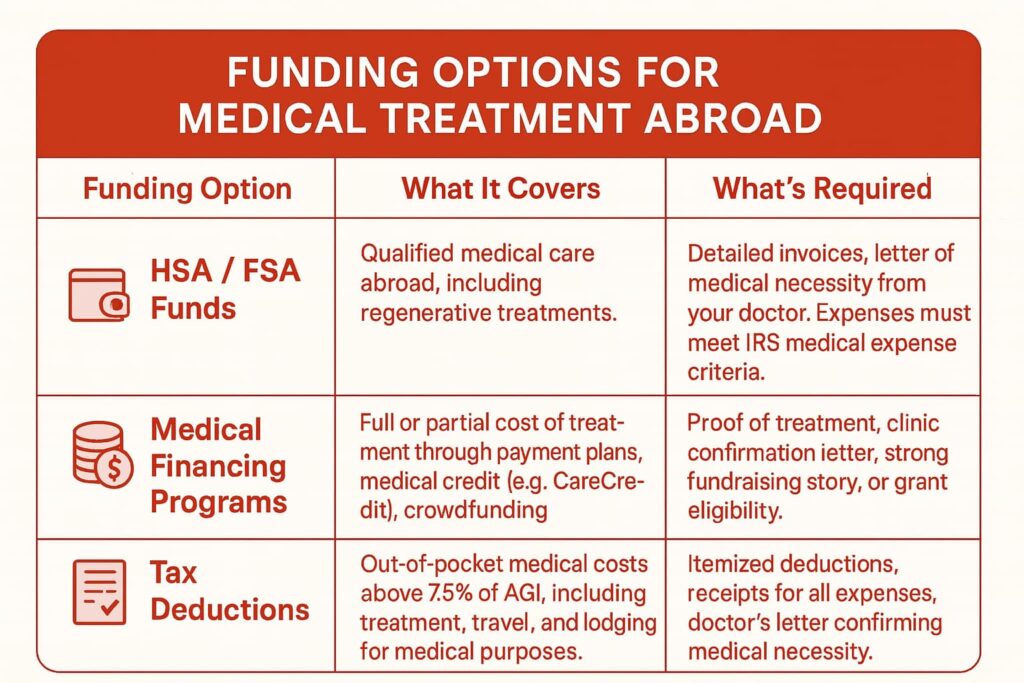“Is stem cell therapy covered by insurance?” is a question that many Swiss Medica patients ask before considering treatment. It’s an understandable concern—stem cell procedures can cost tens of thousands of dollars, so naturally patients want to know if their insurance can help offset the expense.
In reality, most insurance companies do not cover stem cell therapy, as it’s still considered experimental. Certain procedures, such as bone marrow stem cell transplants in hematology or platelet-rich plasma (PRP) therapy, may be exempt from standard policies. But beyond these specific cases, patients are usually left to cover the full cost themselves.
That’s why many Americans explore treatment options abroad, looking for destinations that combine safety, high medical standards, and reasonable prices. Serbia, among others, is increasingly emerging as a top choice, with modern facilities, EU-level protocols, and a lower cost, all within easy reach.
In this article, we’ll outline U.S. insurance options and reveal those that may offer to have the stem cell therapy cost covered by insurance.

Why Insurance Coverage Matters for Stem Cell Patients
Every patient considering stem cell therapy has a unique situation. Before making an informed decision, many of our patients first explore treatment options in their home country, the United States. Here are two reasons they chose a stem cell clinic outside of the USA.
Reason 1. Costs Can Be Prohibitive
Without insurance, the price of stem cell therapy can be prohibitively high. In different clinics, treatments may range from $5,000 to over $30,000, depending on the complexity of the case and the patient’s condition.
For example, a single stem cell injection for an orthopedic issue can cost between $5,000 and $8,000. In the case of neurological diseases—such as multiple sclerosis, Parkinson’s disease, and others—multiple sessions are usually required, and each one can reach $20,000 or more.
Because most standard insurance plans do not cover these procedures, the full cost falls on the patient and their family. When stem cell therapy is covered by insurance, it can significantly reduce the financial burden, but such cases remain rare. This often forces patients to delay or even abandon therapy—especially if traditional treatments have failed—or to look for more affordable stem cell therapy options abroad.
Reason 2. Limited Access to Approved Clinics
Limited insurance coverage is one of the central reasons patients have such restricted access to reputable clinics in the U.S. Since insurers rarely reimburse regenerative treatments, major hospitals have little incentive to adopt them, leaving comprehensive programs confined to research centers and niche private clinics.
This creates a significant gap: patients who cannot enter or do not know about clinical trials are left to navigate a confusing marketplace of more than 2,700 facilities around the U.S. Without clear guidance, they must independently evaluate whether the clinic provides high-quality and safe treatments and ethically sourced stem cells and whether the treatment is truly appropriate for their condition.
The lack of coverage limits access and deepens misconceptions: some may assume that the absence of programs where stem cell therapy is covered by insurance means it is unsafe. In fact, the barriers are often regulatory rather than medical.
The good news is that in the U.S., there are gradual shifts toward supporting regulated, high-quality providers instead of questionable alternatives, with more discussions emerging around making stem cell therapy covered by insurance. In the next section, we’ll look at what’s changing.

Insurance Coverage in the U.S. & FDA’s Position
It’s important to understand that U.S. insurance companies cover only services approved by specific regulatory bodies, which leads many patients to ask, “Is stem cell therapy approved?” One of the most influential in this area is the U.S. Food and Drug Administration (FDA), which sets the rules for experimental and innovative medical practices. This means that, in most cases, stem cell therapy is covered by insurance only if it meets FDA approval standards. Let’s look at them.
FDA-Approved Treatments (What’s Actually Covered)
The FDA has approved only a very narrow range of biological products, and these are the only types of stem cell therapy covered by insurance.
- Hematopoietic stem cell transplants for blood cancers
Hematopoietic progenitor cells from cord blood (HPC, Cord Blood) are used primarily in hematology in U.S. hospitals that perform stem cell transplants. These products contain blood-forming stem/progenitor cells extracted from umbilical cord blood and are used to treat blood and immune system disorders (e.g., inherited immunodeficiencies, leukemia, aplastic anemia).
Important: They are not approved for other uses, such as treating neurological, orthopedic, or cardiovascular diseases.
- Platelet-Rich Plasma (PRP) in very limited orthopedic cases
The FDA has cleared only certain devices that prepare PRP for mixing with bone grafts during surgery to repair bone defects. Medicare and some other insurers will cover PRP for chronic non-healing wounds (like diabetic ulcers) within approved clinical trials.
Important: In consumer advisories, the FDA explicitly states that regenerative products, including PRP, are not approved for treating osteoarthritis, tendonitis, back pain, or other orthopedic conditions. As a result, cases of stem cell injections for back pain covered by insurance are extremely rare.
Most other stem cell treatments in the USA can be offered only under strict conditions.
Why Most Therapies Are Denied
Why isn’t stem cell therapy covered by insurance? There are several reasons for that:
“Experimental” classification by insurers
At present, the use of stem cells—and regenerative therapy in general—is not fully approved by the FDA, as it is still considered experimental and innovative. This is normal; any new area of science or medicine takes time to become a standard. The same is true in pharmaceuticals, where new drugs require years of research and trials before approval.
Currently, the FDA authorizes the use of stem cell therapy primarily within clinical research programs, precisely to improve treatment effectiveness and prove maximum safety.
Lack of large-scale clinical trial data
Insurance companies follow the FDA’s lead and are also waiting for more large-scale clinical trials and long-term outcomes data. Insurers like Cigna explicitly state in their policies that such treatments are “not medically necessary” due to insufficient evidence. As a result, there are currently very few cases of stem cell therapy covered by insurance.
However, the regulatory landscape is shifting. In July 2025, Florida passed a law allowing licensed physicians to use certain FDA-unapproved stem cell therapies in orthopedics, wound healing, and pain management—joining Utah and Texas in loosening restrictions. While these state laws do not override federal policy, they signal a gradual change in how regenerative medicine may be regulated in the future.
Get a free online consultation
Do you need help evaluating whether stem cell therapy could be the right medical and financial choice in your case? Fill out the form for a free online consultation, where our medical team will review your case and determine if this therapy could suit you.

Medical Advisor, Swiss Medica doctor
Types of Stem Cell Therapy Rarely Covered in the U.S.
Some categories of stem cell treatments are almost never covered by insurance, sparking ongoing debate about this question: Does health insurance cover stem cell therapy in any form?
Orthopedic (knees, hips, spine)
Patients may sometimes hear that certain policies could cover orthopedic cases. Unfortunately, in most situations, the answer to the question “Is stem cell therapy for knees covered by insurance?” is no.
Procedures for joint damage, degenerative disc disease, or sports injuries are considered investigational. Even PRP for knee osteoarthritis is excluded by Medicare and most private plans, leaving patients to pay out-of-pocket or seek treatment abroad.
Discover everything you need to know about stem cells for knees in our detailed article.
Neurological (MS, ALS, Parkinson’s, stroke)
These uses also remain experimental, with no routine coverage from Medicare or major insurers. Patients often turn to fundraising or overseas clinics to access treatment.
Even though insurance does not cover these cases, there are clinical studies making progress for patients with complex conditions.
- Autism treatment with stem cells is being explored for its potential to improve cognitive and behavioral outcomes.
- Multiple sclerosis stem cell therapy aims to slow disease progression and restore neurological function.
- Researchers are also investigating stem cell therapy for ALS, seeking ways to protect and regenerate motor neurons to improve quality of life.
Autoimmune & Anti-Aging
Therapies for lupus, rheumatoid arthritis (outside HSCT trials), or any rejuvenation/“longevity” purpose are considered elective and not medically necessary.
If you are interested in lupus stem cell therapy, read our dedicated article covering how it works, its potential benefits, and the latest research.
Note: In all these cases, the lack of coverage is less about proven benefit and more about the absence of full FDA approval and large-scale evidence.
An Overview of Insurance Companies and Programs in the U.S.
Let’s investigate various programs and their policies regarding stem cell therapy.
Medicare & Medicaid
Some of the most well-known insurance programs in the U.S. do not include stem cell therapy in their coverage packages. Here is how they define health insurance for regenerative medicine coverage:
| Program | Coverage for PRP & Stem Cell Therapy | Exceptions |
| Medicare | Does not cover PRP injections or stem cell therapies for most conditions. | Coverage for PRP only in specific cases, such as chronic, non-healing wounds (e.g., diabetic foot ulcers), and only if the patient participates in a clinical trial. Approved cell therapies: CAR-T and cord-blood hematopoietic stem cell transplants are generally covered when medically necessary, performed at certified/accredited centers, and typically require prior authorization with full documentation. |
| Medicaid | Similar to Medicare—generally no coverage for PRP or stem cell therapy. | Coverage for PRP and approved stem cell therapies is limited to very specific situations and clinical trial conditions. |
Medicare has recently updated its regulation policy. In 2025, the Centers for Medicare & Medicaid Services (CMS) changed reimbursement rules for regenerative products (such as skin substitutes), reducing the list of covered products to just a handful and removing many others.
Employer-Sponsored & Private Insurance Plans
Major private insurers—Cigna, UnitedHealthcare, Aetna, Blue Cross Blue Shield, etc.—largely take the same hard line. Their medical policy documents explicitly exclude most regenerative treatments:
| Program / Insurer | Coverage for PRP & Stem Cell Therapy | Exceptions | 2025 Policy Changes |
| Cigna | Lists stem cell therapy for orthopedic and musculoskeletal conditions as “not medically necessary.” PRP is labeled “unproven and experimental” in all cases. | Coverage is limited to certain FDA-approved uses (e.g., HSCT for specific blood cancers). | Maintains conservative stance; no major 2025 policy changes reported. |
| UnitedHealthcare, Aetna, Blue Cross Blue Shield | Classify most regenerative medicine uses as “experimental” or “investigational.” Denials are common for MS, ALS, osteoarthritis, spinal cord injury, and cartilage repair. | Coverage is typically limited to FDA-approved uses; rare exceptions occur in self-funded employer plans or workers’ compensation cases. | Policies are unchanged in 2025; they continue to require more evidence or FDA approval before expanding coverage. |
Veterans Affairs (VA) & Military Coverage
Veterans and military insurance programs generally do not include regenerative therapy, except for the use of bone marrow transplants for cancer treatment. Any other therapy remains classified as experimental and is conservatively excluded from coverage by these organizations, meaning it is rare that stem cell therapy is covered by insurance.
| Program | Coverage for PRP & Stem Cell Therapy | Exceptions | Notes / 2025 Policy Context |
| VA Healthcare | Covers stem cell therapy only for approved, standard indications—primarily bone marrow (hematopoietic) stem cell transplants for cancers in VA hospitals. | No coverage for experimental or non–FDA-approved uses. The VA’s MS Centers of Excellence state that autologous HSCT for MS is experimental and not offered. Veterans are advised to avoid for-profit, unaccredited stem cell centers. | Conservative approach—therapies must be proven, FDA-approved, and part of VA protocol. |
| Military Insurance (Tricare) | Generally follows the VA’s conservative approach—no coverage for elective or experimental regenerative therapies. | Pilot coverage of PRP injections for mild-to-moderate knee osteoarthritis and chronic lateral epicondylitis (tennis elbow) under a provisional program lasting up to 5 years. Some HSCT transplants have been covered for elite military personnel in specific cases, including chronic mild to moderate osteoarthritis of the knee and lateral epicondylitis (under certain conditions). | The PRP pilot program represents a small exception; otherwise, it aligns with FDA-approved, standard uses. |
If Insurance Won’t Pay, These Strategies Can Help Fund Your Treatment
While the situation may seem discouraging, many Swiss Medica patients explore alternative options to have their stem cell therapy cost covered by insurance or supported through various funding programs.
1. HSA/FSA Funds
If you have a Health Savings Account (HSA) or Flexible Spending Account (FSA), you can use these funds to pay for qualified medical care abroad—including regenerative treatments. HSA/FSA funds are not limited to insured procedures; they simply must be used for legitimate medical expenses. This can save you money by allowing you to pay with pre-tax income (reducing your costs by your tax rate).
You’ll need detailed invoices and a letter of medical necessity from your doctor to substantiate the expense. According to IRS guidelines, expenses for the diagnosis, cure, mitigation, or treatment of a disease (and related transportation) qualify as medical expenses. If your physician recommends stem cell therapy for osteoarthritis or a neurological condition, that should be sufficient documentation.
2. Medical Financing Programs
You can request confirmation of your treatment from the clinic to apply for a loan from medical credit companies (e.g., CareCredit in the U.S.), which sometimes provide low- or zero-interest promotional loans for healthcare. Simply ask them, “Does insurance cover stem cell therapy?”
Additionally, crowdfunding platforms (such as GoFundMe) can be used to raise money for treatment, especially if you have a compelling medical story. It’s also worth checking whether charitable foundations related to your condition offer grants, as some nonprofits help fund experimental treatments for specific diseases.
3. Tax Deductions
Despite rare cases when stem cell treatment is covered by insurance, there is another option to reduce your medical expenses. In the U.S., all out-of-pocket medical expenses exceeding 7.5% of your Adjusted Gross Income (AGI) in a year may be tax-deductible if you itemize deductions. This includes costs for medical therapies abroad. Keep all receipts for treatment, travel, and accommodation connected to your medical trip.
The IRS considers travel primarily for—and essential to—medical care as part of deductible expenses. For example, airfare to Serbia for stem cell therapy or lodging during treatment can be included (within certain limits). To claim this, you’ll need a doctor’s letter confirming the treatment was medically necessary, plus detailed documentation of all costs.
You can combine these strategies. For example, use HSA funds to cover a part of stem cell treatment costs, raise additional funds through crowdfunding, and claim eligible tax deductions. While it requires effort and organization, these strategies can significantly reduce the financial burden and stress of high-cost treatments.
Example: See how our patient from Slovakia organized a crowdfunding campaign to help cover treatment for her father with multiple sclerosis.
Note: These recommendations are general. Always consult a lawyer or tax professional to confirm your eligibility and ensure compliance with regulations.

International Options: Where Stem Cell Therapy Is Legal & Affordable
After exploring funding options, many patients look abroad for stem cell therapy that offers both higher quality and lower cost. Growing reports of life-changing results have fueled global interest, creating a boom in international clinics—some excellent, others less reliable. Before choosing Swiss Medica, patients often compare other destinations that promote themselves as leaders in regenerative medicine. We have compiled a list of the most reputable countries with legal stem cell therapy from which you can choose.
Mexico
Mexico, one of the closest options to the U.S., offers lower prices for regenerative treatments such as orthopedic and anti-aging therapies. However, regulation is inconsistent: Mexico’s Federal Commission for the Protection Against Sanitary Risks (COFEPRIS) oversees clinics, yet standards and quality are not always the same.
Panama
Panama is well-regarded for regenerative medicine, thanks to respected facilities like the Stem Cell Institute in Panama City. Its evolving regulatory framework allows certain protocols still considered experimental in the U.S., attracting patients with conditions such as spinal cord injuries, multiple sclerosis, and autism. While prices are generally lower than in the U.S., they remain higher than in Mexico or India.
India
India is an emerging hub for medical tourism for stem cell therapies, offering low costs and high standards in many hospitals. Clinics provide a wide range of stem cell treatments, from orthopedic to neurological. Centers like Giostar treat degenerative and genetic conditions with both autologous and allogeneic mesenchymal stem cells. However, protocols are often standardized, and extra services such as on-site rehabilitation may be limited compared to more full-service clinics.
Another rising favorite among patients is Serbia.
Serbia—The Safe, Affordable Alternative You Might Not Know About
If you’re from the U.S., Serbia might feel like a small, faraway country to consider for treatment. In reality, it’s a European-level country and an international travel hub. Stem cell treatments in Serbia are regulated under European standards, offering a high level of both safety and treatment effectiveness.

Up to 50% Cost Savings Compared to the U.S.
Serbia is considered one of the cheapest countries for stem cell treatment, offering the same treatments at a fraction of U.S. costs—often 50% lower. For example, a stem cell therapy that might be $20,000 in the U.S. could cost around $7,000–$8,000 in Serbia, yielding enormous savings for patients. To illustrate the contrast:
| Location (2025) | Typical Cost Range for Stem Cell Therapy |
| United States | $10,000–$50,000 (depending on treatment) |
| Serbia (e.g. Swiss Medica Clinic) | $7,000–$20,000 / €7,000–€31,000* for various programs |
*Prices are indicative, based on January 2025, and may vary with condition severity and cell quantity required.
As shown above, even the high end of a comprehensive treatment program in Serbia may be less than the low end in the U.S. When evaluating options, patients should consider that the stem cell transplant cost with insurance in the U.S. often exceeds what patients would pay directly at licensed clinics abroad. Savings come from lower operating costs and favorable exchange rates, not lower quality.
Legally Approved & Internationally Recognized Protocols
Serbia legally regulates stem cell treatments to EU-level safety standards, with government oversight and strict protocols for cell sourcing, processing, and care. Top clinics operate under Good Manufacturing Practice (GMP), undergo regular inspections, and meet high medical standards.
Multilingual, Highly Trained Medical Staff
Serbia’s leading clinics, like Swiss Medica, offer highly trained, English-speaking medical staff with decades of regenerative medicine experience, many trained abroad. Most doctors and nurses speak fluent English, with translation services available.

Western European Quality Without the Price Tag
Serbia delivers Western European healthcare quality at Eastern European prices. Here’s an overview:
- EU-regulated care. Clinics follow European Union standards for cell handling.
- Strict quality control includes pathogen screening and imaging-guided injections.
- Lower cost of business operations and taxes reduces expenses for doctors’ fees, lab work, and facilities.
- Western-level hospitals have state-of-the-art equipment, private rooms, and high hygiene standards.
- Significant savings. Comparable care costs far less than in Germany, Spain, or other Western countries.
Swiss Medica is a stem cell therapy hospital in Europe that began in Switzerland before moving to Serbia. The relocation made it possible to keep world-class medical standards while greatly lowering the costs of stem cell therapy.
It’s worth noting that Serbia is also a pleasant place to visit—it’s safe and culturally rich, and many nationalities (including U.S. citizens) don’t need a visa for a short stay. This makes the overall experience of treatment and travel comparatively hassle-free.
See the stem cell therapy experience at Swiss Medica through the eyes of our patient from the U.S.
How to Get Started with Stem Cell Treatment Abroad: 4 Important Steps
If you’ve decided to pursue stem cell therapy overseas, a bit of prep work and planning will ensure the trip goes smoothly. Here’s how to get started:
Step 1. Preparing for Travel with Health in Mind
- Plan for mobility & comfort—request free wheelchair assistance at airports, choose nonstop flights when available, or split long trips for rest, and consider extra legroom or business class for comfort after treatment.
- Bring assistive devices—pack mobility aids (cane, walker, braces); these aren’t counted toward carry-on limits. Bring medical equipment like CPAP machines onboard without penalty.
- Pack a medical kit—carry all medications (plus extras) in original packaging in your carry-on, along with a doctor’s letter, prescriptions, and a small first aid kit.
- Prepare medical documents—keep electronic and hard copies of medical records, and check vaccination or travel health requirements before departure.
By preparing thoughtfully, you’ll set yourself up for a more comfortable journey and avoid health setbacks en route to treatment. Remember that travel itself can be tiring, so plan some rest for your itinerary.
Step 2. Choosing the Right Clinic
Selecting a reputable clinic is the most important decision you’ll make for your treatment abroad. Here’s what to look for when evaluating clinics:
- Specialized expertise—pick clinics experienced with your specific condition.
- Safety & accreditation—look for GMP-certified labs and transparent cell sourcing. Avoid vague claims or “guaranteed cures.”
- Pre-travel consultation—expect a thorough review of your records, a tailored treatment plan, and an honest discussion of expected outcomes and risks.
- Multilingual support & logistics—ensure clear communication, translation services, and help with travel arrangements, accommodation, and local transport.
- Post-treatment follow-up—choose clinics offering ongoing monitoring, rehab, and direct contact after you return home.
Contact us
At Swiss Medica, we are ready to answer any questions you have about eligibility and treatment plans without any obligation. If you are exploring your options, book a free online consultation to explore safe and effective therapy options tailored to your needs.

Medical Advisor, Swiss Medica doctor
Questions to Ask Before Booking
Once you’ve decided on a clinic, bring a list of questions to ensure that you’ve made the right choice. Here are some important ones, organized by category:
Medical & Safety Questions
- What type of stem cells will be used, and where are they sourced from? How are donor cells screened?
- What realistic results can I expect for my condition, and how long does improvement usually take?
- What are the risks or side effects, and how often do they occur?
- Is this treatment part of a clinical trial or an established protocol?
- What follow-up care is included, and how will you support me after I return home?
ITravel & Accommodation Questions
- Can you help arrange airport transfers and hotel stays?
- Is the clinic fully wheelchair accessible?
- Can a companion stay with me, and are facilities available for caregivers or children?
- How long should I plan to stay from arrival to departure?
- Do staff speak English or my preferred language?
Costs & Payments Questions
- What exactly is included in the quoted price?
- Are there extra fees I should anticipate?
- What payment methods and currencies do you accept?
A reputable clinic will be transparent and patient in answering everything, whereas a shady one might evade specifics or pressure you to sign up quickly.
Planning for Recovery Abroad After Stem Cell Therapy
Travel can be long and tiring. When scheduling your stem cell therapy, give yourself the gift of time—especially after treatment. Your body needs quiet days to respond to therapy. Leaving immediately can cause additional discomfort and stress in your body.
- Stay longer locally—allow a few extra days post-treatment for monitoring and rest before flying home.
- Take it easy—light sightseeing is fine, but avoid overexertion; follow your doctor’s activity restrictions.
- Arrange help—travel with a companion or ask the clinic about support services, equipment, or nursing care.
- Follow instructions—stick to your prescribed meds, rehab, and therapy routines, even while abroad.
- Prepare for contingencies—keep medical records handy, know how to contact your clinic, and have travel health insurance for unexpected issues.
Many of our patients actually enjoy the extra downtime—it can be a chance to relax, reflect, and maybe enjoy a bit of the local atmosphere at a gentle pace once the hardest part (treatment) is over.
Contact us
You’re not alone in this journey—we’re here to guide and support you. Our medical advisor will carefully review your history, answer all your questions, and see if stem cell treatment is right for you. Simply leave your contact details, and we’ll arrange a free online consultation for you.

Medical Advisor, Swiss Medica doctor
FAQ
1. Does insurance cover stem cell therapy? And if so, does Medicare Part B or Advantage cover stem cell therapy for knee osteoarthritis?
No. Medicare and Medicare Advantage don’t cover stem cell therapies. Also, they do not offer insurance for PRP therapies for orthopedic conditions. Exceptions are rare and limited to clinical trials for certain chronic wounds.
2. Can I use my HSA or FSA funds to pay for stem cell therapy abroad?
It is possible. HSA/FSA funds can cover qualified medical expenses, including stem cell therapy overseas, if it’s for a specific medical condition. Keep invoices and a letter of medical necessity from your doctor.
Patients often also ask us about insurance coverage, and the best approach is to check directly with your provider—ask them, “Does insurance cover stem cell therapy?”—since coverage rules may vary depending on the policy.
3. Is stem cell therapy tax-deductible under IRS rules in 2025?
Yes, if your annual medical expenses exceed 7.5% of your income and you itemize deductions. This includes treatment and related medical travel. Documentation is essential. Visit IRS.gov for further details.
4. Are there U.S. clinical trials for stem cell therapy that might be covered?
Many patients ask, “Does insurance pay for stem cell therapy?”, and in rare cases, participation in certain clinical trials may offer partial coverage. Trials often provide therapy at no or reduced cost if you qualify. Check ClinicalTrials.gov for opportunities.
5. How much does stem cell therapy cost in Serbia vs. Mexico or Panama?
- Serbia: $7k–$31k (up to 50% less than U.S. prices).
- Mexico: $2.5k–$20k, a wide range depending on the clinic.
- Panama: $15k–$30k, sometimes higher for complex protocols.
List of References:
Leigh Turner, The American stem cell sell in 2021: U.S. businesses selling unlicensed and unproven stem cell interventions, Cell Stem Cell, Volume 28, Issue 11, 2021, https://doi.org/10.1016/j.stem.2021.10.008
Tamouza Ryad , Volt Fernanda , Richard Jean-Romain , Wu Ching-Lien , Bouassida Jihène , Boukouaci Wahid , Lansiaux Pauline , Cappelli Barbara , Scigliuolo Graziana Maria , Rafii Hanadi , Kenzey Chantal , Mezouad Esma , Naamoune Soumia , Chami Leila , Lejuste Florian , Farge Dominique , Gluckman Eliane. Possible Effect of the use of Mesenchymal Stromal Cells in the Treatment of Autism Spectrum Disorders: A Review. Frontiers in Cell and Developmental Biology, Volume 10 – 2022. doi.org/10.3389/fcell.2022.809686
Gugliandolo, A., Bramanti, P., & Mazzon, E. (2020). Mesenchymal Stem Cells in Multiple Sclerosis: Recent Evidence from Pre-Clinical to Clinical Studies. International journal of molecular sciences, 21(22), 8662. https://doi.org/10.3390/ijms21228662
Aljabri Ammar, Halawani Alhussain, Bin Lajdam Ghassan, Labban Suhail, Alshehri Samah, Felemban Razaz. The Safety and Efficacy of Stem Cell Therapy as an Emerging Therapy for ALS: A Systematic Review of Controlled Clinical Trials. Frontiers in Neurology, 12, 2021. https://doi.org/10.3389/fneur.2021.783122
MD, Pediatrician, Regenerative Medicine Specialist







